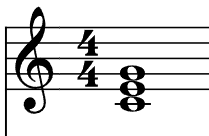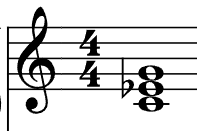
The C Major Triad is a “happy” sounding group of three stacked notes. Here are the characteristics of a triad – three notes, stacked one above the other:

We build this triad by using the 1st, 3rd, and 5th scale degrees. (Recall that a “scale degree” is the position of the note on the scale, and we start numbering from the first note in the scale. So C to B are numbered 1 to 7.)
The chord pictured above, starting from the bottom up, is built on three notes: C-E-G. The first two notes, C and E, are called a dyad, and are three notes apart when we begin counting the steps.
We begin counting with the first note, C, which is number 1.
D is note number 2.
E is note number 3. So C and E are 1 and 3. C and E are a “third” apart by number, so we call this interval a “third.”
F would be number 4, and G is number 5.
This is also a 1-3-5 chord if we are just looking at numbers. This first dyad, C to E, is two whole steps apart, making this a major triad when all three notes are played together.
- The second interval, (from note E to note G), are NOT a major third, but instead are a MINOR third apart. Using the WWHWWWH rule, we discover this fact, finding the two notes are one-and-a-half steps apart, unlike the first interval, which was two steps.
- The first and last note of the chord are exactly 5 steps apart, making this chord a fifth when the first and fifth notes are played together.
Here’s a rule: When the second note in a chord is two steps away from the first note, you are building a Major triad, regardless of the scale you are working with. Scale can be C, D, E, F, G, A, B… whatever.
Below is my YouTube video on building major triads. Watch this at the risk of learning more about triads.
Now, to build a Minor Triad, all we do is follow the steps above, follow the rules above, and flat the third.
When we flat the third, instead of playing the white key E, we play the black key to the left. This is flattened half-step maneuver that works well and creates our sad chord. The completed chord looks like this:

Assignment: Play with this on your keyboard. Practice making major dyads, triads, and then making them sound sad, then happy. Maybe even write a song using your new found skills!
